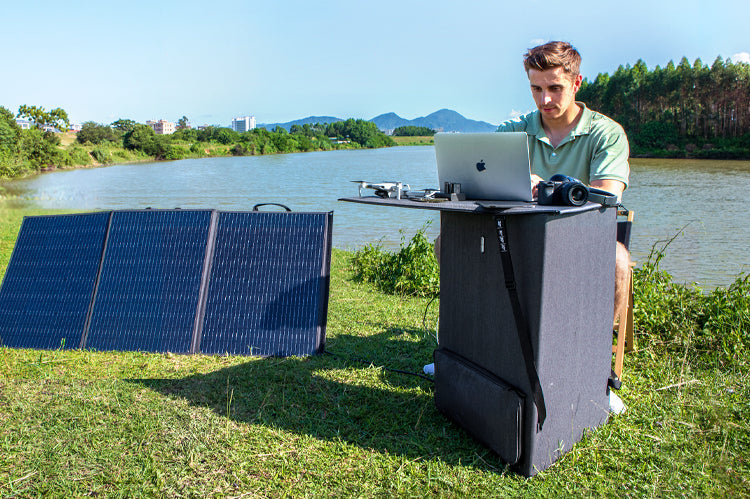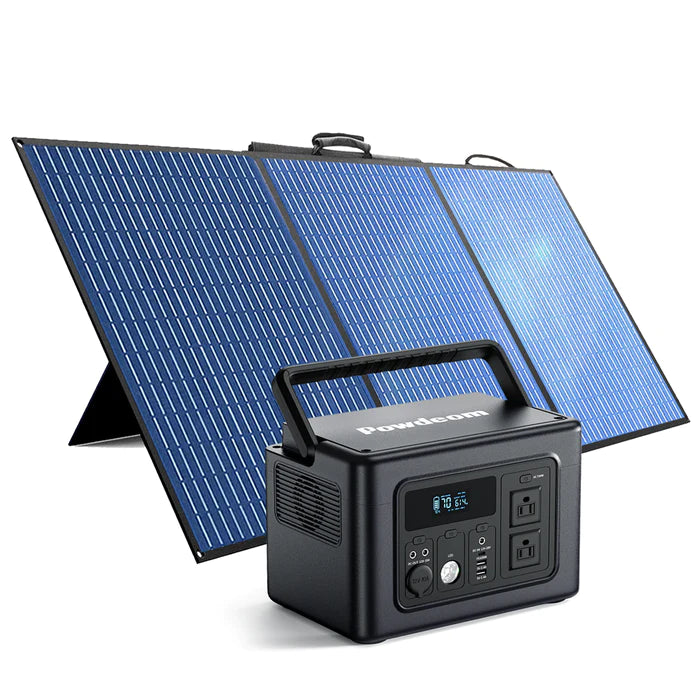Blog

Everything You Want To Know About MPPT
The amount of energy generated by a solar design may be estimated with some precision using mathematical modeling, although this requires careful attention to a wide range of component characteristics. Modeling software must consider whether or not the inverter(s) employed are capable of "global maximum power point tracking" to prevent over or underestimating the system's energy output.
We'll go into the meaning of "global maximum power point monitoring" and why it's crucial to take into consideration in this piece.
What Is An MPPT Charge Controller?
The term "Maximum Power Point Tracking" (MPPT) refers to a method of controlling the charging of a storage battery bank. An MPPT charge controller's role is similar to that of a car's gearbox. The wheels don't get the most power possible when the gearbox is in the incorrect gear. The reason for this is that the engine is operating outside of its optimum speed range. The transmission's job is to transfer power from the engine to the wheels in a manner that allows the engine to operate in an optimum speed range regardless of the vehicle's acceleration rate or the surface over which it is traveling.
Whenever a load is connected directly to a solar panel, the operating point of the panel is not at peak power. The operational point of the solar panel is determined by the resistance it encounters. As a result, the operating point may be shifted toward the peak power point by adjusting the impedance observed by the panel. A DC-DC converter is used to change the impedance of one circuit (source) to another DC circuit since panels are DC devices (load).
When the DC-DC converter's duty ratio is adjusted, the resulting impedance is read off of the screen and displayed. The operational point is located at the maximum power transfer impedance (or duty ratio). Changes in air conditions, such as radiation and temperature, may significantly impact the panel's I-V curve. Since working circumstances are always changing, setting a constant duty ratio would be impractical.
Increasing The Voltage Of The Panels To Extract Maximum Power
For batteries to be charged this way, the solar panel's output voltage must be higher than the batteries' voltage to allow current to pass from the panel to the battery.
The panel's voltage output varies with environmental conditions such as temperature and humidity (irradiance). The actual output voltage may be greater than the specified value on a bright day, whereas it is more likely to be lower on a gloomy day. Regular controllers can't use the greater output voltage to pump out additional juice. On the other hand, MPPT charge controllers may alter the voltage to increase the current at peak demand. With their ability to fine-tune the voltage-to-current ratio, MPPTs can charge batteries to greater depths than their specifications allow.
What Are The Advantages Of MPPT?
The power produced by the solar array may be determined by monitoring the DC voltage and current at the system's output and using the maximum power point tracking algorithm. Since MPPT may aid in producing greater power outputs, it can be used to better effect in almost any solar-related application; more benefit would be received when the module's operating voltage is high. During low solar radiation and high temperatures, power may be lost unless Maximum Power Point Tracking is used.
The mini-turbine, wind turbine, and other sectors might benefit from using an MPPT solar charge controller as well.
MPPT would reduce complexity and boost efficiency in the system.
What Is The Difference Between MPPT And PWM Charge Controllers?
Charge controllers manage the energy produced by solar panels. It controls the flow of electricity to the batteries by adjusting the voltage and current. A charge controller regulates the battery's voltage to avoid overcharging and undercharging. So, it serves to safeguard the system. A charge controller is essential to every solar power setup. Separated into two categories, charge controllers are either PWM (Pulse Width Modulation) or Maximum Power Point Tracking (Maximum Power Point Tracking)
PWM is an abbreviation for "pulse width modulation." Power factor correction (PWM) charge control devices may be considered electrical switches. Turning the switch on and off is a simple process. Thus, the batteries may be charged to the appropriate voltage. The charge current will be gradually reduced as the batteries are fully charged.
Maximum PowerPoint Tracking describes this method to its fullest. In other words, maximum power point tracking is a method for monitoring and controlling energy flow from solar panels to storage batteries. Power generation from solar panels varies with the seasons and other environmental factors.
By regulating the voltage between the solar panels and the batteries, MPPT charge controllers improve the effectiveness of the charging process. Using the P = V x A relationship, these setups make the most of solar panels by equitably distributing the power between the two variables. When the sky is overcast, less current is pulled from the panels to save voltage. Sunnier days allow for higher current consumption limits.
The primary difference between PWM and MPPT, charge control devices, is efficiency. The charging efficiency of MPPT control devices is 30% higher than that of PWM type devices. In PWM systems, it's important that the panel voltage and battery voltage be in sync. It is acceptable for the panel series to have a greater voltage than the batteries in MPPT systems. There will be greater room for expansion as a result.
However, MPPT controllers are more costly than PWM controllers. This is why PWM charge controllers are still widely used in low-power applications where efficiency is less concerned.
When selecting a charge management device, it is vital to consider the whole system size of the solar power installation. Professional use is best served by maximum power point tracking charge controllers. PWM charge regulators may do the trick in low-power situations when more features aren't necessary. There may need to be more of a difference in efficiency between PWM and MPPT to warrant the cost difference in less significant projects. However, it is crucial to the system's success when it comes to major projects.
There are essentially four key distinctions
When comparing MPPT and PWM charge controllers, the former is the more efficient option. PWMs have a conversion efficiency of roughly 75%, whereas MPPTs may reach efficiencies of 95%.
Price-wise, PWM charge controllers are more attractive than MPPT charge controllers. Popular PWMs typically cost between $20 and $50, whereas inexpensive MPPTs may be purchased for about $100.
Multiple solar panels are often wired in parallel when using a PWM charge controller. Most maximum power point tracking charge controllers may be wired in series with PV systems because of their high PV voltage restrictions. Because of the larger current (amperage) produced by parallel wiring, heavier wire and devices with higher current ratings may be necessary.
Smaller solar arrays, typically between 300 and 400 watts, are ideal for PWM charge controllers. Higher-powered solar systems (often those producing 400 watts or more) benefit greatly from MPPT charge controllers. MPPTs become more economically viable as solar array size increases.
Are MPPT Solar Charge Controllers Worth It?
While the MPPT is more efficient overall, it is not well-suited for low-power devices. The MPPT charger controller is essential for high-output systems that rely on more than one solar power grid. If the voltage from the panel is more than 8V, the MPPT should be utilized instead of the PWM. Also, their power output efficiency is 30% higher than the PWM's, meaning they provide greater throughput.
As the panel's voltage rises, the MPPT's power output also increases. For instance, a 160W panel consisting of 36 regular monocrystalline cells with a maximum power amp of 8.4A would output about 8.6A at 12V. The 180W panel, which contains four different cells, will still provide the same amperage but at a higher voltage of 2V.
Is it prudent to purchase an MPPT controller?
Dealing with a high-voltage solar panel grid is very dangerous without the MPPT. Since they are around 30% more efficient than PWM technology, they have found widespread application in major companies. They are also considerably easier to utilize than PWM in low-light or overcast conditions. Therefore, the device's throughput is much higher than competing technologies.
The only drawbacks are a more initial investment, higher maintenance costs, greater physical size, and lower lifetime compared to PWM. But with MPPT, things will be different for the better for the user.
To Sum It Up
While MPPT controllers are more costly, they allow for more panel flexibility. Because of the battery bank's higher voltage, the PV module's voltage will decrease, causing a higher current to flow.
Increased amperage leads to quicker charging. These solar charge regulators will fine-tune themselves according to the P = V x I equation. This means that, in contrast to PWM, you'll get more power to charge the battery without waste.
With an MPPT controller, a solar array's voltage may be greater than the battery bank's. Where irradiance is low, this is particularly crucial in the winter when daylight hours are shorter.
They improve charging efficiency by 30% compared to PWM. More adaptability will facilitate system growth. This is crucial for commercial enterprises. Typically, their warranties are longer than those of PWM models.
MMPT should be employed in high-output battery devices as an alternative to PWM technology. Besides improving the device's productivity and throughput, it is easier to use. However, PWM must be prioritized for low-power devices since formal charges are wasteful.

One Of The Sustainable Energy-Solar Power
Solar photovoltaic power plants are widely recognized as an important environmentally friendly energy option. Recently, there has been a proliferation of innovative solar technologies that enable bringing your electricity with you wherever.

How To Store Your Solar Energy?
Even the most optimistic proponents of solar energy acknowledge that their technology has one major drawback: it can only generate power when the sun is out. However, most people consume energy at their homes at their highest rate in the evening, when solar power is at its lowest point. But the sun shines during those off-peak hours, and solar panels may generate more than enough electricity to supply the grid during the day's peak hours. This suggests that there is a great deal of potential for both households and companies to benefit from effective solar energy storage.

How To Charge Your Device Quicker Than Others?
USB Power Delivery (PD) is a standard for rapidly charging electronic devices that have significantly improved over the years. A variety of electronic equipment may now be activated quickly by the use of this technology. To simplify charging many devices simultaneously, utilize a Type-C charger. Therefore, it is a simple, efficient, and secure method of charging electronic gadgets. Smartphones and laptops with increasingly powerful processors use more energy. Because of this, USB PD is poised for widespread adoption. These developments pave the way for a future in which immediate powering-up and sharing power are not just possible but commonplace.

Quick Charge About Power Station
Powered by an external controller and gate-signal generator, the Bidirectional-Convert block simulates a bidirectional DC-DC converter that may boost or drop DC voltage across its terminals.
What Is Bidirectional-Convert Technology
A Bidirectional-Convert is a converter that can switch between direct current (DC) and alternating current (AC) either way. Including a DC/DC converter and an AC/DC converter that can work with power from the DC or AC grids. This technology allows for reversible energy flow between residential and industrial facilities. More work is being done to improve this bidirectional power source. There is now a wider variety of portable electronics available. What sorts of impacts are impacted by the storage battery's voltage shift and what types of circuit design are needed to avoid those effects need to be known there at the testing time.
Particularly, "the voltage falls as the output current rises," "the electrical characteristics change between completely charged or low battery," and "the electrical parameters differ between new and deteriorated goods" are all features of the battery. As long as we have yet to determine what sort of battery is utilized in gadgets, it is important to test various patterns in the average home. However, this makes it challenging to prepare many batteries in advance.
As a result, the two-way power source serves as a stand-in for a battery. In most cases, the DC power source that serves as a simulator will be advertised as programmable. As a programmable power source, bidirectional power is at the cutting edge of innovation. High current converter testing for EVs requires a Bidirectional-Convert power supply that can reach high voltages.
Smooth current switching is achieved without a notch at the cross point, even without overshooting the target of the current waveform, which is especially useful for converter testing that involves repetitive operation and regeneration. It is safe to subject the rechargeable battery to repeated stress testing without worrying about damaging it by overcharging or undercharging. The power source has several applications, such as a CV/CC or CV/CV converter.
What Is The Benefit Of This Technology For Power Station
Recharge Fast
The use of intelligent EV charging is gaining traction quickly. But just what does that phrase entail? Or why can't we use standard wall outlets to charge our EVs? Smart charging provides a stable foundation for other intelligent energy services and guarantees a trouble-free charging experience. It helps you save cash while decreasing your carbon footprint. The smart charging devices & features are highlighted, along with their top five advantages.
Can Directly Charge Many Devices Which Need AC Output Without Any Adapter
Yes, it is safe to charge a gadget using a charger with a higher current capacity than required. Given that the voltage is maintained at a constant (5V), the only variable in current flow is the load (another name for impedance) the device exerts on the charger.
Heat UP The Volume
The use of maximum charging power is made safe by smart charging equipment. This allows for a significantly quicker charging time than with standard wall outlets.
Smart devices automatically check the connection between the automobile and the device before initiating the charging event, greatly increasing the security of smart charging. Dynamic load management may improve safety when many charging stations are located on the same site. If necessary, charging events may be halted remotely.
Watch How Much Power You're Using
If your neighbours complain about your high power bills, you may end the argument by linking your recharging device to a service that automatically records your use. In this case, the EV owner bears the burden of the charging fee. Users of work vehicles will appreciate the service's ability to report public or home charging expenses to the employer automatically.
Charge at the most cost-effective time of day using smart charging technology. Since energy rates are set in response to consumer demand, this is good for the ecosystem and the power grid. Charging electric vehicles at the optimal time helps maintain a stable electrical grid and reduces the requirement for new power plants.
Locate Power Locations
Connected charging stations allow drivers to check availability and make reservations for the stations they need to use. In addition, motorists may assist one another while bringing in some additional cash by renting out their charging stations. The gadget's user can set access controls for himself, his contacts, or the whole network.
Multiphase Master/Slave Design For Two-Way Power Converters
The LT8708 from Analog Devices is a buck-boost shifting regulator controller for 12-to-48-volt bidirectional power converters. The LT8708 is a bidirectional, 80 V, 4-switch buck-boost DC-DC regulator with a maximum load current of 30 A. The LT8708 master may work in tandem with additional slave chips to provide greater current as required. Since a single (more costly) master IC may control numerous (cheaper) slave ICs in an enslaver/enslaved person architecture, it can help cut solution costs in multiphase systems.
When more enslaved people are wired into the master, the system's power and current capacity grow in direct proportion. Still, for the enslaved person to conduct current or strength in the same way as the LT8708 requires the same conduction modes. When using an LT8708 multi-stage system, the master sets the maximum allowable current and voltage, and the enslaved people adjust to fit within those parameters.
The Importance Of Bidirectional Power Factor Adjustment For Grid-Interactive Bevs
Using large bandgap semiconductors allows for the totem-pole topology to be used in PFC applications using constant-current mode (CCM) operation. To achieve this efficiency level at half load, one Infineon IMZA65R048M1 CoolSiC MOSFET in a TO-247 four-pin packaging is employed. The converter is designed to work primarily with high line voltage (minimum 176 volts RMS, nominal 230 volts RMS) in CCM at a switching frequency of 65 kilohertz (kHz).
Take our product as an example–
It Can Recharge From 0-80% In An Hour With Wall Charge
EV charging allows for rapid recharging; it can be powered back up to 80% capacity in under an hour. The maximum power charged from a solar battery generator with just an AC outlet is 940W.
It Can Charge Many Small Appliances ( EG: Vans, Computer, Micro-Wave Oven,Hair Dryer....)
Small gadgets like microwave, hair dryer will only use a little power regardless of the voltage level, portability, or brand you choose. So we can easily use EV charging to charge small appliances.
POWDER EN700 Portable Power Station –
There is no such thing as a fast-charging AC adapter. With lightning-fast 60m charging, you'll never miss a chance to travel. Charge from empty to 80% in under 1 hour when plugged into a wall outlet. It's seven times as fast as standard, fifty-three per cent quicker than the BLUETTI EB55, and seventy-four and a half per cent quicker than the Jackery Explorer 500.
Huge 614 WH Capacity, 100 Watts Of Power Dissipation
Quick charging, two 700W AC outlets, two DC outlets, two USB-A ports, one vehicle port, and eight total device charging ports are all supported. You can ditch the cumbersome converter thanks to the 100W USB-C output and rapidly charge your laptop with only a single connection.
Because of its long life of about 3000+ charge 100% cycles, the EN700 may be used virtually daily for over ten years. To wit, LFP battery chemistry provides more than simply durability. It maintains its superior dependability, effectiveness, and safety under hot conditions. We've covered you for the following five years since EN700 boasts one of the best warranties in the business.
We've ensured you can charge your EN700 in almost any situation by including three different charging choices. Fast solar charging is available for those interested in grid-free or helping the environment, while rapid charging through an AC outlet is ideal for those who need their devices quickly charged. Just plug it in anywhere there's a power outlet, and you're good to go.
There is no such thing as a fast-charging AC adapter. With lightning-fast 60m charging, you'll never miss a chance to travel. The solar generator may be set from empty in less than an hour using the Powder portable power station since it accepts inputs as low as 500W AC (1.4 hours of full charging)
POWDER OKD150 Laptop Power Bank
When both the DC 30W & PD 65W are connected, the power supply can handle inputs of up to 95W. Get it charged up before you go camping or vacation, and it will be ready in less than an hour.
Battery Pack With A 150-Watt-Hour AC Plug
The power bank's AC plug, rated at 150W, may be used to charge & power a wide variety of devices (Rated power below 150W), such as laptops, small refrigerators, fans, lights, and other camping equipment.
Dual-Direction Power Delivery (PD) 65W Port
Your power station will be ready with the 2-way 65W rapid charging that allows you to charge your phone, tablets, laptops, or other electrical gadgets at record speed. Compared to a USB-C connector, the input power and setting time are significantly sped up.
There are three USB ports, one Quick Charge 3.0 port, one Power Delivery 65W port, one AC 150W mains adapter, and one DC output on this battery pack. It would make camp life easier by allowing you to charge many gadgets simultaneously.
The battery bank's built-in Batteries Management System (BMS) safeguards it against damage caused by overheating, overcharging, over current, and short circuits, so we never skimp on safety.
Three Methods of Recharging
It may be charged and utilized to its full potential wherever you are: in the great outdoors while camping, on the road when travelling, or at home while relaxing.
Conclusion
The active power transported from the DC grid towards the AC grid is regulated by the Bidirectional-Convert AC-DC/DC-AC converter, which maintains a unity power factor. In addition, it holds a power factor of unity while controlling the active power flowing from the Ac system to the DC grid.

